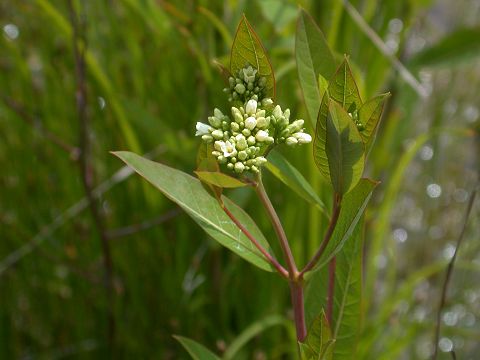

Apocynum cannabinum - (image 1 of 7)
Taxonomy
Family: Apocynaceae
Habitat
Disturbance adapted. Railroads, old pastures, disturbed prairies. Dry or mesic sites.
Associates
Distribution
Local in eastern Canada and New England, frequent from NY west to ND, south to FL and TX. Occasional west to the Pacific.
Morphology
Colonial perennial with milky sap, 0.5 to 1.5 m. Leaves opposite, mostly ascending, petiolate, sharp-pointed. Flowers in terminal cymes surpassed by sterile lateral branches; corollas white to greenish-white, less than twice the length of the calyx lobes. Fruit a pair of many-seeded follicles; coma of seed 2 cm long or longer.
Notes
Flowers June to September
Wetland Indicator: Facultative
The stems are contain long fibers, hence the common name. Rather showy in the fall as it often turns bright yellow. Plants in this genus are highly toxic if ingested, containing a cardiac glycoside (apocynamarin) which can lead to cardiac arrest, but the plants are so bitter ingestion is unlikely.
References
Foster, S. and R.A. Caras. 1994. A Field Guide to Venomous Animals and Poisonous Plants: North America North of Mexico.
Houghton Mifflin Company. New York, NY. 244 pp.
Gleason, Henry A.
and A. Cronquist. 1991. Manual of Vascular Plants of Northeastern United States
and Adjacent Canada. Second Ed.
The New York Botanical Garden. Bronx, NY
Swink, F. and G.
Wilhelm. 1994. Plants of the Chicago Region.
Indiana Academy of Science. The Morton Arboretum. Lisle, Illinois.
|
© Michael Hough 2004 |